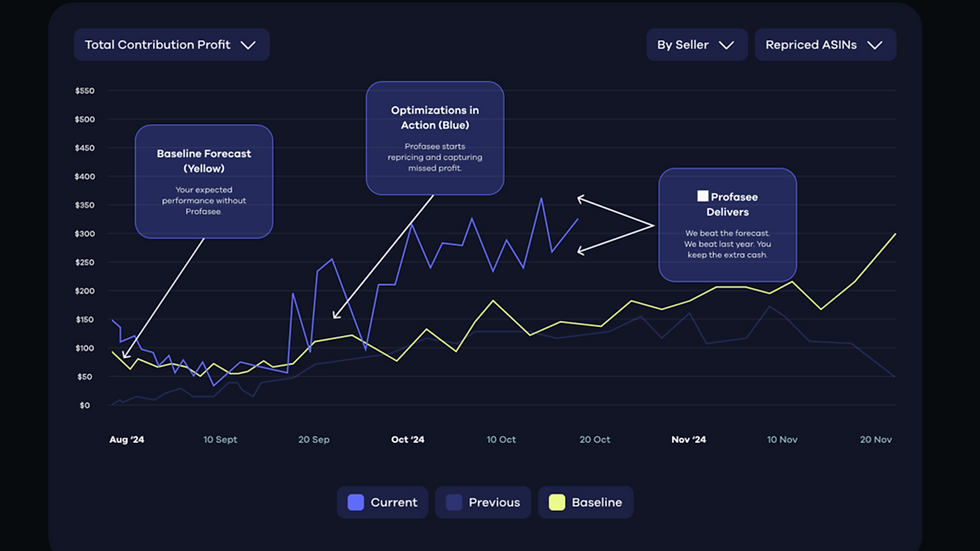60% Price Increase, 2× Profit, Same BSR
- Profasee

- Aug 18, 2025
- 4 min read
Guest Post By: Profasee
Real Amazon case study in the Supplements category. No new listings. No new photos. No added ad spend. Yet profit surged.
TL;DR: Price went up by ~60%, units sold increased, BSR held steady or improved, and profit doubled.
The Backstory
A supplement brand hit a sales plateau. The team assumed prices were already “as high as the market would bear.” They were underpricing. Profasee uncovered the gap and executed a controlled price lift to capture the true willingness to pay.
What changed
● Price increased by ~60%
● Units sold rose instead of falling
● BSR stayed stable or improved
● Profit expanded to the seven‑figure range
This is counterintuitive. Most sellers fear that raising price will tank rank and sales. Done right, it does not.
Why Raising Price Can Improve Results on Amazon
Amazon’s flywheel rewards total revenue and conversion rate, not just low price. If your offer is differentiated and demand is inelastic within a band, a higher price can increase revenue velocity while signaling quality.
Mechanisms at work
● Elasticity bands: Many products have ranges where demand barely changes as price moves. If you are priced below this band, you leave profit on the table.
● Perceived quality: In categories like supplements, price can signal trust. A too‑low price can depress conversion.
● Revenue velocity: Higher price × healthy conversion can maintain or improve rank.
● Inventory alignment: When price reflects real demand, you reduce stockouts and clearance events.
The Profasee Method
Profasee is built for private‑label brands that want the perfect price at each precise moment. Here is the practical playbook we used.
Baseline your floor and ceiling
Pull contribution margin by SKU. Set non‑negotiable profit floors and price caps based on brand strategy and regulation.
Model micro‑elasticity
Use historical price, units, and conversion data to estimate how demand shifts in small price steps. Identify safe lift zones.
Coordinate with ads and inventory
Price, PPC, and inventory must work together. If you raise price, tune bids and budgets so you keep revenue velocity and avoid stockouts.
Stage the lift
Roll out price steps over 7–14 days with guardrails. Watch revenue, CVR, returns, and BSR. Pause or roll back if thresholds are hit.
Lock the win
When the new price band proves stable, expand to adjacent SKUs and refine your floor based on real margins.
Automate ongoing
Keep prices responsive to seasonality, competition, and ad pressure. This prevents reversion to underpricing.
Software with a service: Profasee’s AI runs continuously, and our team helps you set the strategy, guardrails, and tests. You keep control. The system does the heavy lifting.
What The Data Showed
● Price: climbed roughly 60%
● Units: increased instead of falling
● BSR: held or improved, confirming visibility remained strong
● Profit: doubled at the SKU and brand level

When This Works Best
● You have real differentiation: brand, reviews, formulation, warranty, or bundle value
● Conversion is strong but margin is thin
● Inventory is stable and you can fulfill increased demand
● You own the Buy Box on private‑label listings
Avoid if you are in a pure race‑to‑the‑bottom commodity fight where price is the only lever and reviews are weak.
Common Questions
Does raising prices always boost profit?
No. It works when demand is inelastic within a reasonable band and your offer is differentiated. That is why we test in small steps with guardrails.
Will a higher price hurt my rank?
Not if revenue velocity and conversion stay healthy. In this case study, BSR held or improved while price rose.
How is this different from rule‑based repricers?
Rules chase competitors. Profasee predicts your optimal price from many signals and coordinates with PPC and inventory rather than reacting to one input.
How fast can I see impact?
\Most brands see signal within 1–2 pricing cycles after launch. Full effect emerges as the model learns and seasonality shifts.
Is this allowed by Amazon?
Yes. You are free to change your prices. Profasee respects your floors, ceilings, and compliance constraints.
Implementation Checklist
● Confirm COGS and contribution margins
● Define SKU‑level floors and strategic ceilings
● Map ad spend guardrails and budget sync
● Enable Profasee on target SKUs and set test cohorts
● Stage 2–3 price steps with review gates
● Monitor profit, CVR, returns, and BSR in a daily cadence
What Customers Say
“Profasee has been a game‑changer for our brand. If you are in business to make a profit, there is nothing to think about. The ROI made it a no‑brainer.”
Want to see your lift before you change a single price? Try a profit‑lift forecast and see expected impact by SKU.
Book a demo or see the dynamic pricing tool. If your pricing is under market, you are bleeding profit every day.
Key Takeaways
● Underpricing is the silent profit killer on Amazon
● The right price can increase units, hold or improve BSR, and expand profit at the same time
● You need coordinated pricing, ads, and inventory plus continuous learning
● Profasee automates the work while you control the strategy
About the AccrueMe Guest Post Author…
Profasee provides dynamic pricing solutions within the e-commerce sector, using AI to adjust prices in real-time. The company has a platform that adjusts pricing strategies to address market changes and inventory levels.





Comments